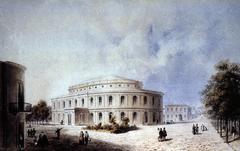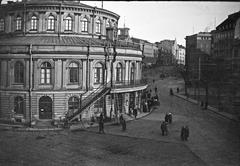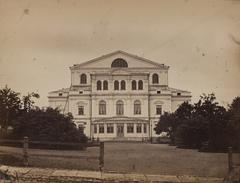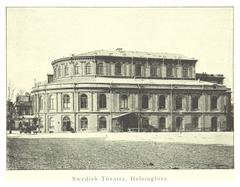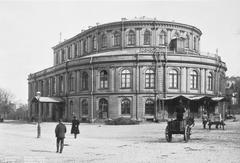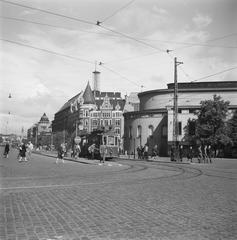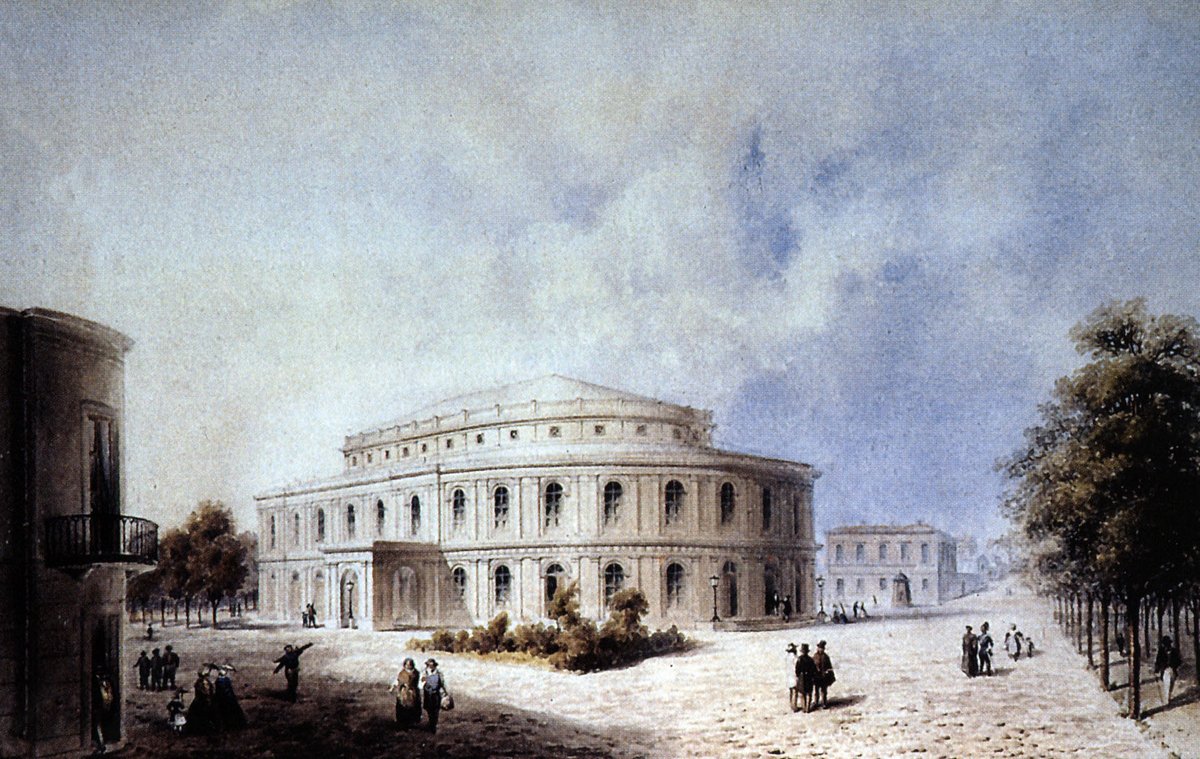
Svenska Teatern Visiting Hours, Tickets, and Guide to Helsinki Historical Sites
Date: 14/06/2025
Introduction
Svenska Teatern, Helsinki’s oldest and most esteemed Swedish-language theatre, stands as a vibrant cultural landmark deeply embedded in Finland’s bilingual heritage and theatrical tradition. Founded in 1866 and located at the heart of the city, Svenska Teatern is more than just a stage—it’s a living testament to the evolution of Finnish society, architecture, and the performing arts. This comprehensive guide details the theatre’s fascinating history, visiting hours, ticketing options, accessibility, nearby attractions, and practical tips to help you make the most of your visit to this treasured Helsinki site.
For up-to-date information on performances, schedules, and ticket purchases, always consult the official Svenska Teatern website.
Table of Contents
- Historical Overview
- Visitor Information
- Architecture and Preservation
- Frequently Asked Questions (FAQ)
- Conclusion & Further Exploration
- References
Historical Overview
Early Foundations
The roots of theatre in Helsinki can be traced to 1827 with the establishment of Engels Teater, designed by Carl Ludvig Engel. This modest wooden structure at Mikaelsgatan and Esplanaden hosted visiting troupes and laid the foundation for Helsinki’s theatrical scene. The absence of a permanent company and heating made winter performances challenging, and by 1866, the building was dismantled and repurposed (Wikipedia, de.wikipedia).
The Move to Erottaja and Nya Teatern
Responding to the city’s growing appetite for culture, a new theatre was built at Erottaja square, designed by Georg Theodor von Chiewitz. Nya Teatern (“New Theatre”) opened in 1860, inaugurating a new era for Helsinki’s performing arts. Its first season featured “Princessan av Cypern” by Zacharias Topelius and Fredrik Pacius, performed by Pierre Deland’s troupe. Initially, all productions were in Swedish, reflecting the dominant language among the educated elite, but soon, the stage became a platform for Finnish as well. Swedish actress Hedvig Raa-Winterhjelm’s introduction of the Finnish language to the stage was a pivotal cultural moment (de.wikipedia).
Reconstruction and the Benois Era
A catastrophic fire in 1863 destroyed most of the theatre, sparing only the semi-circular main wall, which became a defining architectural feature. The rebuilding, under Russian architect Nicholas Benois, was completed in 1866 with a stately neoclassical façade, quickly re-establishing the theatre as a cultural beacon (Wikipedia, de.wikipedia).
Institutional and Architectural Evolution
With the inauguration of the Finnish National Theatre in 1872, Nya Teatern was renamed Svenska Teatern in 1887 to distinguish its Swedish-language programming. Over the years, the theatre underwent significant architectural changes. In the 1910s, Eliel Saarinen added a new annex; the 1935 renovation by Eero Saarinen and Jarl Eklund gave the building its modernist look, streamlining the neoclassical exterior. The 2012 restoration balanced historical conservation with contemporary amenities (Open House Helsinki).
Cultural and Linguistic Significance
Svenska Teatern is a vital institution for Finland’s Swedish-speaking minority, representing about 5% of the population (likealocalguide.com). The theatre has long championed bilingualism, artistic innovation, and cultural dialogue, with performances primarily in Swedish, often accompanied by Finnish and English surtitles to foster inclusivity and access.
Its role extends to social engagement and education, offering workshops, youth programming, and collaborations that nurture emerging talent and reinforce the status of Swedish as an official language in Finland (helsinki.com).
Notable Artistic Contributions
The theatre has premiered influential Finnish works, including several by Jean Sibelius, such as the original “Finlandia” in 1899, and has hosted landmark productions like the musical “HYPE.” Today, it continues to balance classical drama, domestic productions, musicals, and children’s theatre, serving as a training ground and stage for the Finnish-Swedish performing arts community (Wikipedia, stepupschool.fi).
Visitor Information
Visiting Hours
- Box Office: Typically open Tuesday to Friday from 13:00–15:00 and 16:00–18:00, and one hour before performances. Hours may be adjusted for summer holidays—confirm current times on the official website.
- Theatre Access: The building opens about one hour before each performance.
Tickets and Booking
- Online: Purchase via the Svenska Teatern website.
- In Person / Phone: Tickets available at the box office or by phone at +358 9 6162 1411.
- Pricing: Tickets typically range from €20–€60, with discounts for students, seniors, and groups. Family packages are available for select shows (Matilda).
- Advance Booking: Strongly recommended, especially for popular performances.
Accessibility
Svenska Teatern is committed to inclusivity and accessibility:
- Physical Access: Wheelchair-accessible entrances, elevators, and restrooms.
- Assistive Services: Surtitles in Finnish and English for many main stage productions, audio description, hearing loops, and reserved accessible seating.
- Safer Space Policy: The theatre upholds equality and safer space principles (Svenska Teatern Safer Space).
Performances, Surtitles, and Family Features
- Language: All shows are performed in Swedish; most are surtitled in Finnish, with select performances also offering English surtitles via screens or mobile apps such as Subtitle Mobile (Svenska Teatern Matilda).
- Family-Friendly: Early evening and weekend matinee times; family tickets and children’s programming available.
- Repertoire: 8–10 productions per year across three stages (Main Stage, Amos, and Nicken), including drama, musicals, and children’s theatre (Svenskfinland Theater).
Guided Tours and Educational Activities
Guided tours are available for groups (5–25 people) and must be booked in advance (Svenska Teatern Guided Tours). Educational activities, play introductions, and workshops enrich the experience for school groups and theatre enthusiasts.
Nearby Attractions and Travel Tips
- Location: Norra Esplanaden 2 (Pohjoisesplanadi 2), 00130 Helsinki (MyHelsinki), just a 5-minute walk from Helsinki Central Station.
- Public Transport: Trams 2, 4, and 10; nearby bus and metro connections (Travel Melodies).
- On Foot: Centrally located near Esplanadi park, Market Square, Helsinki Cathedral, and the Design District.
- Amenities: Cloakrooms, accessible restrooms, café/bar, and family facilities.
- Parking: Several public garages nearby; spaces can be limited during peak times.
Architecture and Preservation
Svenska Teatern exemplifies Helsinki’s architectural evolution:
- Original Design (1827): Neoclassical by Carl Ludvig Engel.
- 1866 Benois Rebuild: Retained neoclassical grandeur after the fire.
- Modernization (1935): Eero Saarinen and Jarl Eklund’s expansion introduced functionalism and modernist elements, streamlining the façade and enhancing technical facilities (Open House Helsinki).
- Restoration (2012): Upgrades for accessibility, conservation of historical features, and new amenities.
- Key Features: Elegant façade facing Esplanadi, grand auditorium with excellent acoustics, accessible public spaces, and modern backstage facilities.
The theatre’s careful stewardship balances preservation with adaptation, allowing it to serve contemporary audiences while honoring its historic legacy.
Frequently Asked Questions (FAQ)
Q: What are Svenska Teatern’s visiting hours?
A: The box office is open Tuesday to Friday, 13:00–15:00 and 16:00–18:00, plus one hour before performances. Confirm current times on the official website.
Q: How can I buy tickets?
A: Purchase online, by phone, or at the box office. Advance booking is recommended.
Q: Are performances surtitled in English?
A: Most main stage shows are surtitled in Finnish; select performances also offer English surtitles via screens or apps.
Q: Is Svenska Teatern wheelchair accessible?
A: Yes, with accessible entrances, seating, restrooms, and assistive services available upon request.
Q: Are there guided tours?
A: Yes, for groups by advance booking. Tours explore the building’s history and backstage areas.
Q: What nearby attractions can I visit?
A: Esplanadi park, Market Square, Helsinki Cathedral, Design District, and other major theatres.
Conclusion & Further Exploration
Svenska Teatern embodies Helsinki’s rich cultural tapestry and bilingual legacy, serving as both a historic architectural landmark and a dynamic performing arts institution. Its central location, diverse programming, and commitment to accessibility make it a must-visit for theatre lovers, families, and cultural tourists alike. Whether you attend a performance, join a guided tour, or simply admire its neoclassical façade, Svenska Teatern offers an immersive window into Finland’s artistic and linguistic heritage.
For the latest updates on shows, schedules, and ticketing, visit the official Svenska Teatern website. Enhance your cultural exploration of Helsinki with tools like the Audiala app for personalized recommendations and easy ticket bookings.
References
- Svenska Teatern - Wikipedia
- Svenska Teatern (Helsingfors) - Wikipedia (German)
- Svenska Teatern Helsinki - Open House Helsinki
- Svenska Teatern - Helsingin Kaupunki / Helsinki City
- Svenska Teatern - Helsinki.com
- Svenska Teatern Official Website
- Like a Local Guide Helsinki - Svenska Teatern
- Travel Melodies - Visiting Helsinki, Finland
- Step Up School - HYPE Musical
